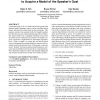243 search results - page 7 / 49 » Extending the mirror neuron system model, I |
TNN
2010
13 years 2 months ago
2010
In this paper we provide theoretical and numerical analysis of a geometric activity flow network model which is aimed at explaining mathematically the scale-free functional graph s...
CVIU
2006
13 years 7 months ago
2006
In this paper we study projection systems with a single effective viewpoint, including combinations of mirrors and lenses (catadioptric) as well as just lenses with or without rad...
GECCO
2007
Springer
13 years 11 months ago
2007
Springer
A primary goal of evolutionary robotics is to create systems that are as robust and adaptive as the human body. Moving toward this goal often involves training control systems tha...
KCAP
2005
ACM
14 years 1 months ago
2005
ACM
An ultimate goal of AI is to build end-to-end systems that interpret natural language, reason over the resulting logical forms, and perform actions based on that reasoning. This r...
AI
2011
Springer
13 years 2 months ago
2011
Springer
The Extended Global Cardinality Constraint (EGCC) is a vital component of constraint solving systems, since it is very widely used to model diverse problems. The literature contai...

